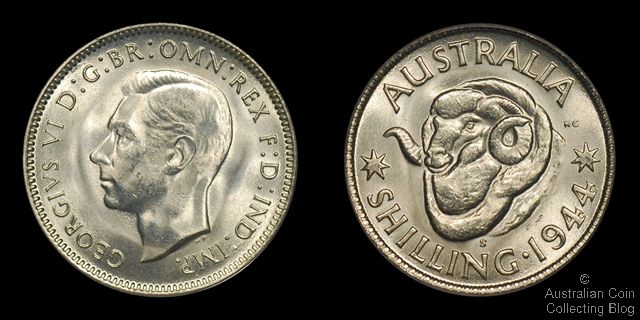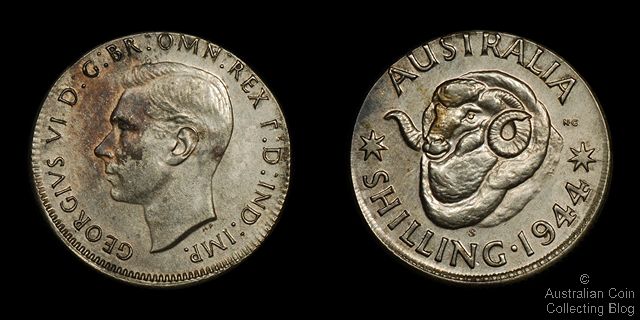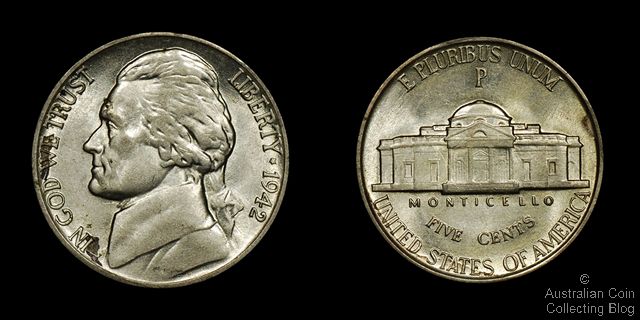Written by The Australian Coin Collecting Blog and published in the Australasian Coin and Banknote Magazine September 2011 Volume 14 No. 8. Reproduced here for your information.
The early years of World War 2 saw the end of the Great Depression, an upswing in the Australian economy which was now on a war footing, and nearly a million cashed up US servicemen taking up residence here. These factors all combined to cause a critical lack of available coinage. Unfortunately the war effort put an unprecedented demand on our manpower and industrial capacity as well as a strain on the cash reserves of the government of the time. The Royal Mint branches in Melbourne and Perth were unable to meet the demand for either bronze or silver coins and the decision was made to manufacture coins overseas. The task fell to India to mint bronze coins in 1942 and 1943 while the USA minted silver coins (3d, 6d, 1s, and 2s) from 1942 to 1944. More than £6 million worth of silver coins were minted in the USA during this period and Australia supplied less than half the silver required for the coins freeing up valuable funds for the war effort. The debt was not repaid until 1956 when £3 million of silver recovered from the debasement in 1946 was supplied to the USA.

Figure 1 : a regular shilling minted in San Franciso in 1944 on a 92.5% silver planchet weighing 5.65g.
One can imagine that the US mints in Denver and San Francisco were intensely busy during this period, fully occupied with minting their own coinage as well as those of several other countries. As well as Australia these countries included Fiji, France, Greenland, the Netherlands and the Netherlands East Indies. To further complicate matters there were big changes going on with the coinage of the USA itself during the War. The USA issued a zinc coated steel cent in preference to the copper cent and also minted the so called 5c silver 'war nickel' instead of the normal 75% nickel / 25% copper coin. Both of these new compositions were designed to preserve metals that were important for war purposes. In the case of the penny, copper was required for use in ammunition while the nickel in the 5c coins was required for use in armour plating.
The frenetic activity at the mints naturally lead to a decrease in quality standards, and this is readily apparent by the number of coin errors issued by the U.S mints during WW2. Australian errors before this period are very scarce by comparison. Clipped planchets, broadstruck coins, and coins struck by filled dies are not too hard to find, but as you'd imagine florin errors are a little tougher than the other denominations. However, there is one error that is a lot scarcer than the others, the so called 'foreign planchet' strike. Contamination of barrels of blank coins of one country or denomination could easily have happened during such a busy time and sure enough this is the case. We are aware of Australian threepences struck on US dime planchets, and shillings struck on war nickel planchets.
Figure 1 shows a regular shilling minted in San Francisco in 1944 on a 92.5% silver planchet weighing 5.65g. Figure 2 shows another shilling struck in San Francisco in 1944, it is readily apparent however that this coin (in figure 2) is not a 'regular' shilling. It has clearly been struck on an undersize planchet which is evident by the missing rim around 50% of the coin's circumference. Fishtailing of the lettering (particularly strong on AUSTRALIA on the reverse) indicates that the planchet was undersize when struck rather than being damaged later. So what has happened here? There are three strong clues to a possible answer. Firstly, the coin weighs 4.95g. Secondly, as shown in the image there's a large patch of poorly mixed copper apparent on the obverse pointing to an alloy relatively rich in that metal. Thirdly, the coin has a darker appearance to a normal shilling than you'd expect.

Figure 2 : another shilling struck in San Francisco in 1944. This coin is not a 'regular' shilling. It has clearly been struck on an undersize planchet which is evident by the missing rim around 50% of the coin's circumference.
Each of these factors point to one answer about what sort of planchet this coin was struck on. It almost certainly was minted on a US silver war nickel planchet of the period (see figure 3 for a US war nickel). War nickels are composed of 56% copper, 35% silver, and 9% manganese and they weigh 5.0 grams. Thus the mass of our mis-struck shilling is consistent to that of a war nickel. Also, a war nickel planchet is rich in copper giving a quite plausible explanation for the copper impurity shown in figure 2. Finally, the manganese content in the war nickel is a neat way of explaining the darker and duller appearance of the coin. Similar observations have been made of war nickels and the 50% silver coinage of Great Britain from 1920 to 1947 which also contained some manganese. The only way to prove without doubt is to have a non-invasive metallurgical composition test conducted on the coin. Another alternative would be to it slabbed and tested by PCGS or NGC. They would label it as an error coin and record the actual composition of the coin on the holder. PCGS offer this service for around $USD310 (incl. shipping). This would boost buyer confidence and perhaps help the coin to realise a higher price if it were to be sold. Without proper metallurgical testing our theories, while quite well supported and logical, are just that, theories.
So how scarce are these war time silver coins that were struck on US or other foreign planchets? The answer is extremely scarce. The coin shown here is the only one the authors have seen at online auction for the last 5 years. Examination of public auction catalogues for all the major Australian auction houses from the last 3 years show the following (likely) wartime silver coins struck on foreign planchets (prices not inclusive of buyers premium):
March 2011 IAG Sale 73 Lot 487 1943s Shilling on War Nickel planchet realised $1,100
March 2010 IAG Sale 71 Lot 460 1943s Shilling on War Nickel planchet realised $1,320
February 2010 Roxbury Sale 77 Lot 694 1943s Shilling on USA alloy planchet for a Nickel realised $620
March 2009 IAG Sale 69 Lot 453 1944s 3d on Dime planchet realised $3,000

Figure 3 : the US War Nickel
There we have it, just a handful of coins; truly these foreign planchet error coins are rare indeed. We know how scarce these types of foreign planchet errors are in the decimal series. Think of the the 1981 20c struck at the Royal Mint in Wales on a Hong Kong scalloped $2 planchet. There are 6 known examples and if you could find one of those for sale we doubt you'd get much change from $15,000 (McDonald's 18th ed EF cv $7,500 seems underrated). We also know of a $2 on a euro planchet, what else is out there?
These foreign wartime planchet Australian errors are interesting finds for the afficionado and perhaps a good investment in better grades due to their scarcity. Certainly one for those from the 'thinking arm of numismatics' to keep an eye out for.
References:
Crellin, A (2009). Australian Coinage During WWII. Retrieved from http://www.sterlingcurrency.com.au/research/australian-coinage-during-wwii
Hanley, T & James, W (1965). Collecting Australian Coins. Sydney, Australia:The K.G. Murray Company Pty Ltd
Hanley, T & Myatt, W (1980). Australian Coins, Notes & Medals, Melbourne, Australia: Castle Books
Zierbath, T (2006). Foreign Coins Manufactured at US Mints. Retrieved from http://www.pdxcoinclub.org/articles/Foreign Coins Struck at US Mints CWNA article with table.pdf
Thanks to Gerry McGinley from 'At the Toss of a Coin', Adelaide for supplying the 1942P War Nickel.
Posted by mnemtsas at April 1, 2013 6:25 PM
Subscribe to our Newsletter


